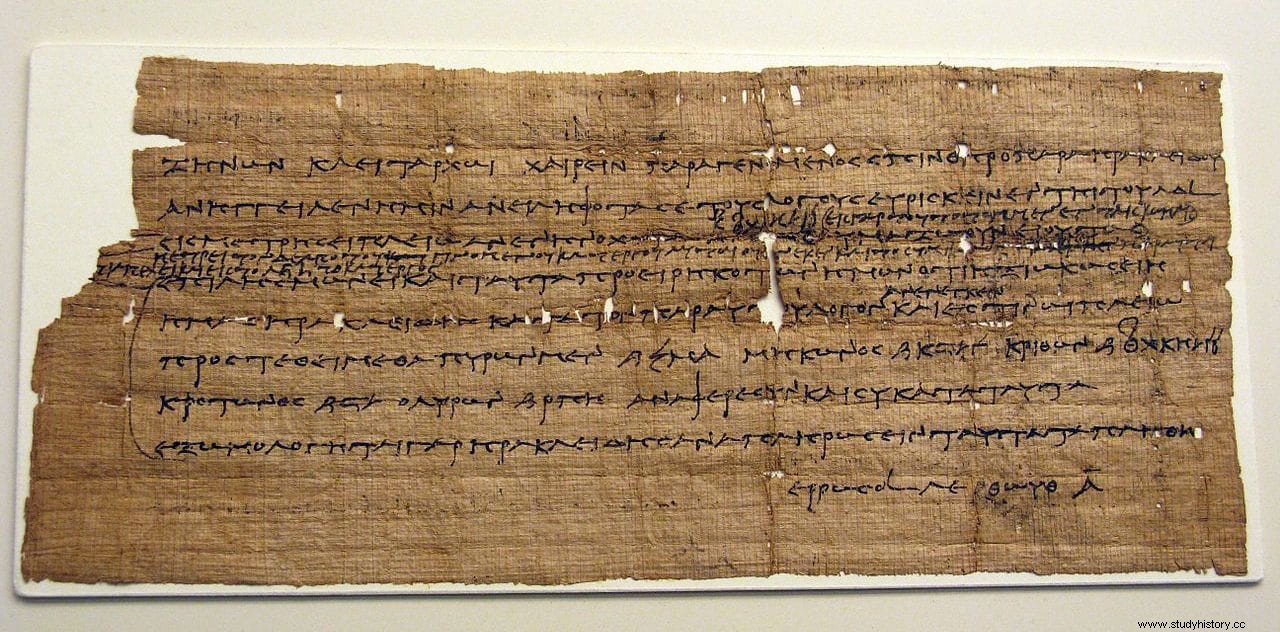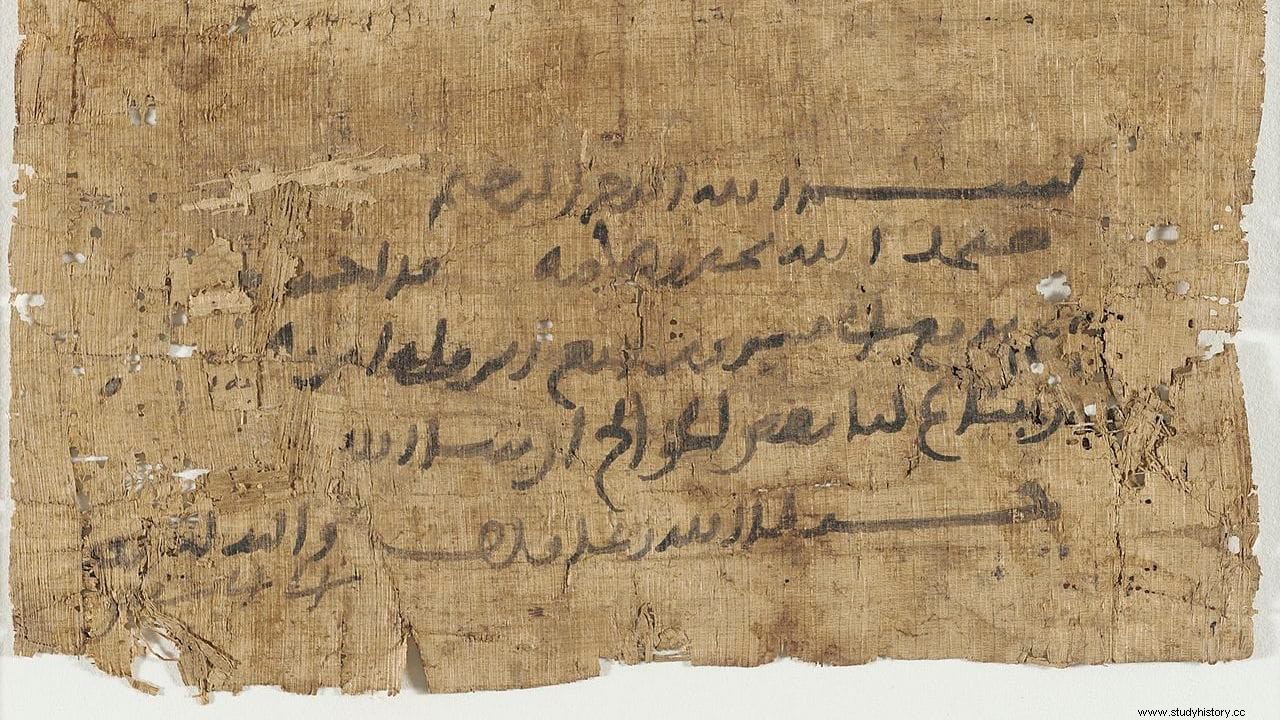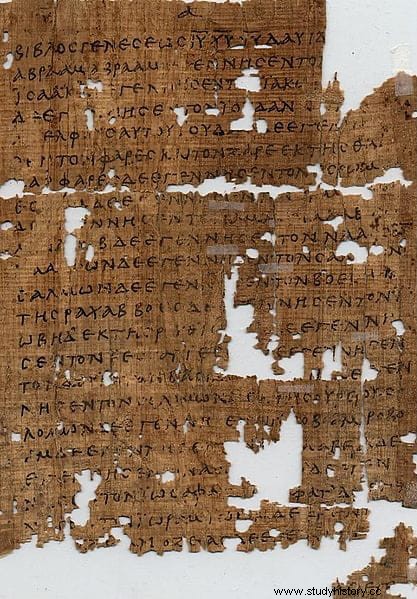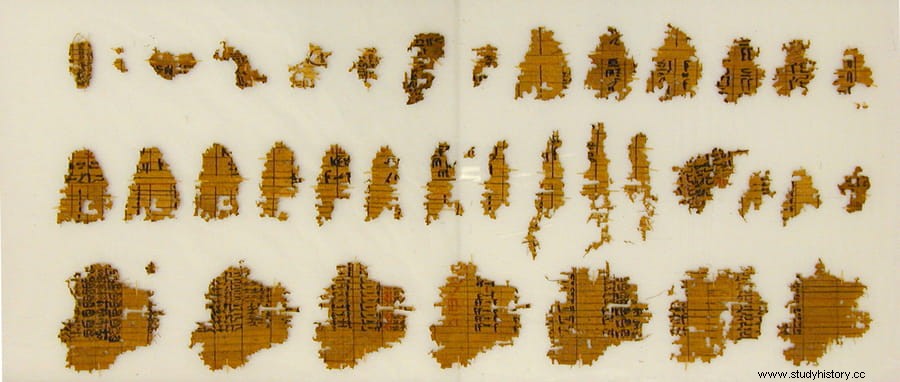Paper, invented in China around the 2nd century BC, did not spread to the rest of the world until much later, since it did not leave the country for half a millennium and it would take until the 11th century for the Muslims to bring it to Europe, specifically to Al Andalus. Until then, other supports were used, ranging from clay tablets to parchment (animal skin), passing through silk, wood, stone or any other usable material. Of all of them, the most important, in terms of quantity and quality, was papyrus.
Papyrus is the name of an aquatic plant (Cyperus papyrus ), a kind of reed that was very abundant on the banks of the Nile, which is why it became the favorite to make a common writing support to replace the limited Mesopotamian system of incised tablets. The differential character was not only in the way of applying the message to it, substituting cuneiform signs for writing itself, but also the versatility it provided, allowing administrative, religious, literary, personal documents to be made...
Although in Egypt the manufacture and sale of papyrus was a real monopoly that allowed us to mentally link this type of support to that country until today, in reality papyrus became common throughout the ancient Mediterranean, also being used by the Greeks and Romans, for example. Its validity did not begin to decline until the 5th century AD. but it still survived until the aforementioned displacement by paper, which means several millennia in activity. It is impossible to even imagine how many papyri were made, but it is possible to make an estimate of those that are preserved throughout the world:approximately 500,000.

Paradoxically, the Cyperus papyrus Egyptian has become extinct due to overexploitation, although it has survived in the wild in other places such as Ethiopia or Sudan and even outside of Africa, such as Sicily or some tropical countries. Pliny the Elder He left a description of the elaboration process and the multiple uses that were given to that proto-paper. Because it wasn't just for writing; Furniture and baskets were also made with it, footwear was made, boats were built and it was even possible to eat.
Furthermore, in the complex Egyptian cosmogony the typical area of growth - especially the Delta marshes in Lower Egypt - was associated with the primeval mound of creation and thus with regeneration. A divine character that was highlighted by associating it with the goddess Wadjet (protector of Lower Egypt and related to fertility) and was reflected in the decoration of the temples, in addition to raising the plant in religious processions and assuming that the boats of the gods were of that stuff.
Obviously, the main use was writing, but Pliny distinguished eight types of papyrus according to their quality; from smallest to largest they were:Emporitic, Taeneotic, Saitic, Amphitheatric, Fanian, Livian, and Augustan. These names already give us an idea that papyrus was also in common use in the classical world, hence a good part of what is preserved is not only Egyptian. We have papyri written in hieroglyphics, hieratic, and demotic, just as there are in Coptic, Greek, Latin, and Arabic.

It is necessary to take into account that Egypt, after its period of splendor, went through successive stages of domination. The Ptolemaic was respectful of the pharaonic administrative system and simply placed Greeks at the head of the nomos (provinces), with the Hellenic language as the official language despite the cosmopolitanism that cities like Alexandria acquired. Greek endured as a written referential language even after the Roman conquest, displacing popular demotic (although they were sometimes combined) and Latin only appears in documents in specific cases.
The Greek colonization of Egypt focused mainly on the lower Nile and El Fayum, which is why these are the areas that have left us the most papyri. Almost all of them are Byzantine, after the 3rd century AD, found from the last third of the 19th century. They are multi-themed, from product relationships to birth records, going through divorces, offerings to temples, financial memorandums, love letters, tax lists... The oldest surviving Greek papyrus is a marriage contract signed on Elephantine Island in the year 311 BC, shortly after the conquest of Egypt by Alexander the Great.
In the last decade of the nineteenth century, the British archaeologist William Flinders Petrie made a discovery as unexpected as it was curious:the cardboard of many Ptolemaic mummies from the Hawâra and Gurob necropolises was made by recycling papyri in Greek, some commercial, others personal and some, surprisingly, with literary fragments of Homer, Euripides and Plato. Shortly after, just beginning the 20th century, Bernard Grenfell and Arthur Hunt found that not only was Strabo telling the truth when he spoke of the mummification of sacred crocodiles, but also that the cardboard of the specimens they unearthed was also based on papyrus.

That mix of demotic and Greek that we were saying before evolved into Coptic, which took advantage of alphabetic characters from both and which, in turn, branched out into 6 dialects. It was widespread between the 3rd and 8th centuries AD, especially among early Christian communities. These still exist in the country and maintain the language despite the fact that from the 7th century it began to be replaced by Arabic, whose writing is of Nabataean origin. However, the Muslim papyri are not unitary, since there are some with Kufic and Naskhi scripts; The current one comes from the latter, cursive type.
In general, the information in a document must be extracted from the context it narrates, it is not frequent that exact data, dates or places appear. That is why papyri are usually classified into two basic types:literary and non-literary. The theme of the former is clear and needs no further explanation; of the narrative are famous the Story of Sinuhé and the Poem of Pentaur , for example, although the list is longer and is expanded with fantastic literature on stories of gods. It can also include from verse compositions to religious works or treatises on magic (the Book of the Dead ), as well as wisdom treatises (Teachings , Tips ), domestic issues that go beyond the typical (Erotic Papyrus of Turin ), etc.
The non-literary ones cover a very broad thematic spectrum, as we listed before, and reflect many aspects of everyday life. For example, economic activity:the notes of moneylenders and financiers reveal the rates of merchandise of the time (copper, textiles, honey, exchange rates of precious metals...), cost of boat tickets, patterns of real estate purchase and real estate, currency fluctuations, payments in kind and even the price of gifts within the family.

The issuing source can be governmental of course. Tribute lists, property records, grain storage statistics, reports on land productivity, notices of theft or embezzlement from the state, tax ratios for various products, from wine to beer to cereal or oil, the latter another state monopoly. And pay slips with the salary of officials and soldiers, items for public games, birth certificates...
Likewise, the written contracts include information on employment conditions, amount of leases and rents, etc. A very interesting variety of contracts are marriage contracts, thanks to which we know more about nuptial agreements, dowries and conditions for married life. Also on how to carry out separations and divorces, with complementary issues such as child support or unwanted pregnancies. The Oxyrhynchus Papyri , a set of several, are a gem in that sense.

There is also no lack of private correspondence, both between family and friends, officials or clients. These are often instances addressed to the administration requesting help or influence, but there are also purely parental ones that inquire about the health of a loved one, ask for an item that is difficult to obtain, or announce an upcoming visit. One can cite, for example, the papyri found in the temple of Abusir. And don't forget prescriptions and other forms of medicine.
All this enormous amount of data constitutes an invaluable source to delve into the knowledge of life in ancient times and the best thing is that researchers have access to it thanks to the implementation of a project called APIS. The name refers to the famous Egyptian god in the shape of an ox and surely it has been played with, but the truth is that they are nothing more than the acronym for Advanced Papyrological Information Symposium , the patient work of collecting and reproducing papyri carried out by a consortium of universities and museums.
The objective of APIS is to publish on the Internet all the papyri that exist today to facilitate the work of academics and the public, providing, in addition to its scanned image, a description. In the US there are 6 institutions involved:the universities of Duke, Berkeley, Michigan, Columbia, Yale and Princeton. Together they gather the majority of the papyri in that country, about 45,000, a significant amount but which leaves the rest pending -remember, around half a million-, despite the fact that other world organizations have also joined, such as the universities from Heidelberg, Oxford, Lecce and Copenhagen.

But in the meantime, papyri continue to turn up in the excavations and another project called Ancient Lives comes into play. , created in 2011 by the Egypt Exploration Society, the Citizen Science Alliance and the University of Oxford to translate the texts that are found with the help of 250,000 volunteers.
